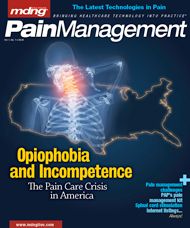Publication
Article
MDNG Pain Management
Breakthrough Pain
//Medical Websites
Breakthroughcancerpain.org
This site, divided by information for patients and professionals, can serve as a quick reference source for doctors seeking background information on breakthrough pain. Each section of the site offers information and some visuals, such as X-rays, tables, or flow-charts. For example, the “Diagnosis” section provides readers with an algorithm on diagnosing breakthrough pain that features key indicators. A number of case reports throughout the site offer insight; titles include “Breakthrough Pain should Be Distinguished from Background Pain,” “Impact and Management of Breakthrough Pain in Cancer,” by Dr. G Zeppetella, and “BTCP Clinical Assessment and Tools,” a video presentation by Dr. A Davies. In the “Professional Resources” section, visitors can explore the site’s library of conference slides and presentations, along with links to articles, professional papers, and more.
Link Code: pm3311
//The Educated Patient
Online Guide to Breakthrough Cancer Pain
The American Pain Foundation’s Online Guide to Breakthrough Cancer Pain offers patients advice on pain management and information on what to expect in regards to breakthrough pain, what causes the pain, and how to discuss it with their doctor. The introduction page describes how unrelieved pain can affect a patient’s lifestyle by limiting his or her “ability to work, sleep, or exercise;” or by “lowering self-esteem.” On this page are links to content created by APF staff, including the articles “The Basics of Breakthrough Cancer Pain,” “Facing Your Fears: Making Pain Management Part of Your Cancer Care,” and “Talking with Your Cancer Treatment Team.” Each article discusses well-known techniques and provides information from surveys and studies to help educate patients. For example, on the “Facing Your Fears…” page, the writers describe the six common misconceptions and fears that breakthrough pain sufferers have about reaching out for help, including accepting pain as an “unavoidable part of having cancer” and fear that pain is “a sign that cancer is spreading.”
Link Code: pm3321
Pain Control: A Guide for People with Cancer and Their Families
Send your patients here to review common questions and answers on breakthrough pain. The American Cancer Society’s Pain Control Guide offers facts on general cancer pain, the causes, tips on controlling it, and medications commonly used, along with a special section on breakthrough pain. In this section, are commonly asked questions, such as “Can I take my chronic pain medicine and my breakthrough pain medicine at the same time during the day?” and “Why did my doctor prescribe 2 different opioid pain medicines?”
Link Code: pm3322
//eAbstratcs
The Use of Opioids for Breakthrough Pain in Acute Palliative Care Unit by Using Doses Proportional to Opioid Basal Regimen
Journal: The Clinical Journal of Pain (May 2010)
Authors: Mercadante S, Villari P, Ferrera P, et al
Purpose: “To determine the efficacy and safety of different opioids used in doses proportional to the basal opioid regimen for the management if breakthrough pain.”
Results: Results demonstrate that “doses of opioids for BP proportional to the basal opiod regimen are effective and safe in clinical practice, regardless the opioid and modality used.”
Link Code: pm3351
Efficacy of Intranasal Fentanyl Spray Versus Other Opioids for Breakthrough Pain in Cancer
Journal: Current Medical Research and Opinion (May 2010)
Authors: Vissers D, Stam W, Nolte T, et al
Purpose: “To compare the efficacy of intranasal fentanyl spray (INFS), oral transmucosal fentanyl citrate (OTFC), fentanyl buccal tablet (FBT) and oral morphine (OM) for the treatment of breakthrough cancer pain (BTCP).”
Results: Both OTFC and FBT had similar results and were less effective then INFS, but “superior to placebo” in pain reduction. OM was only more effective than placebo 45 minutes in and onward. Researchers concluded “INFS is expected to provide the greatest improvement in the treatment of BTCP” and OM should not be considered as an effective treatment option because of “its slow onset to effect.”
Link Code: pm3352
//Clinical Trials
Safety and Efficacy of PMI-150 for Breakthrough Pain in Cancer Patients
Study Type: Interventional
Age/Gender Requirements: 18 years (male/female)
Sponsor: Javelin Pharmaceuticals
Purpose: This study will be performed on patients, who have experienced episodes of breakthrough pain, and require “around-the-clock opioids” for cancer pain. Researchers will “assess the safety and efficacy of Intranasal Ketamine as an analgesic for the treatment of breakthrough pain.”
Link Code: pm3361






